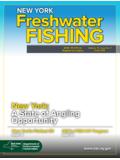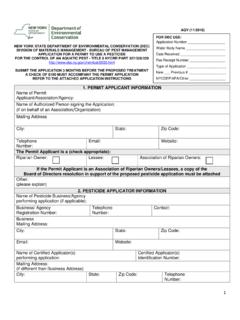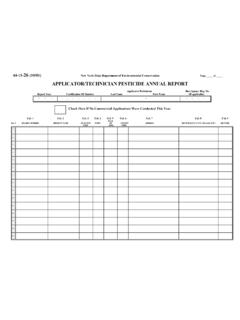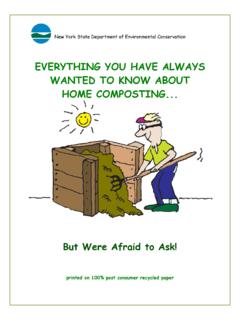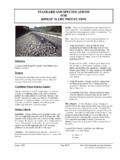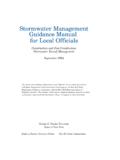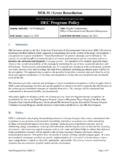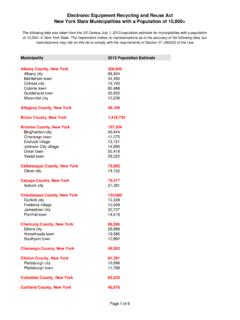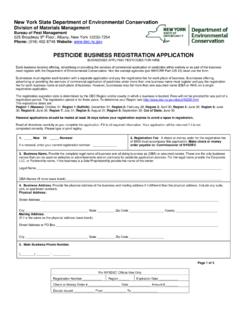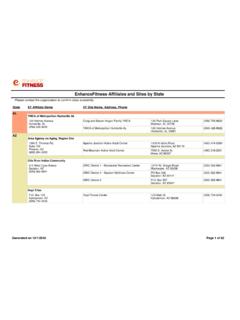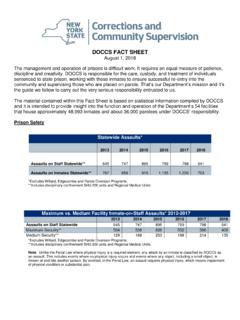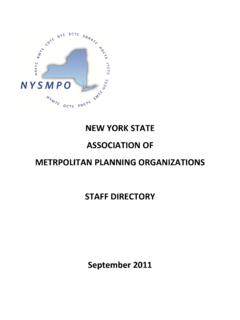Transcription of Environmental Compliance Assistance for Small …
1 New york State department of Environmental conservation 625 Broadway, Albany, NY 12233 Environmental Compliance Assistance For Small BUSINESSES Table of Contents REGULATORY v SECTION I - REGULATIONS .. 2 HAZARDOUS WASTE REGULATIONS .. 2 HOW TO IDENTIFY YOUR HAZARDOUS WASTE .. 2 COUNTING YOUR HAZARDOUS WASTE .. 5 CONDITIONALLY EXEMPT Small QUANTITY GENERATORS .. 7 Small QUANTITY GENERATORS .. 8 LARGE QUANTITY GENERATORS .. 11 EPA IDENTIFICATION NUMBER .. 12 THE MANIFEST SYSTEM .. 13 LICENSED TRANSPORTER .. 15 LAND DISPOSAL RESTRICTIONS .. 16 EXCLUSIONS OR RECLAMATION EXEMPTIONS .. 17 MOST COMMON HAZARDOUS WASTE VIOLATIONS .. 22 WATER REGULATIONS .. 23 INTRODUCTION .. 23 BEST MANAGEMENT PRACTICES (BMPs) .. 23 PRETREATMENT PROGRAM .. 23 NONPOINT SOURCE PROGRAM .. 24 AIR REGULATIONS .. 26 INTRODUCTION .. 26 VOLATILE ORGANIC COMPOUNDS (VOCs) .. 26 PERMITTING REQUIREMENTS.
2 26 EXEMPTIONS .. 27 REGULATION OF HAZARDOUS AIR POLLUTANT EMISSIONS .. 27 CHEMICAL AND PETROLEUM STORAGE .. 28 TANK REQUIREMENTS .. 28 CHEMICAL AND PETROLEUM SPILLS .. 33 i SECTION II - DESCRIPTION OF WASTE STREAMS .. 34 ACIDS/BASES .. 34 REACTIVES .. 34 HEAVY METALS/INORGANICS .. 34 SOLVENTS .. 35 DRY CLEANING FILTRATION RESIDUES .. 35 IGNITABLE WASTES .. 36 INK SLUDGES CONTAINING CHROMIUM AND LEAD .. 36 LEAD ACID BATTERIES .. 36 SPENT PLATING AND CYANIDE WASTES .. 36 WOOD PRESERVING AGENTS .. 37 PESTICIDES .. 37 SECTION III BEST MANAGEMENT PRACTICES .. 39 MANAGEMENT PRACTICES .. 39 GOOD HOUSEKEEPING .. 39 INVENTORY CONTROL .. 40 EMPLOYEE TRAINING .. 40 MATERIAL SAFETY DATA SHEETS .. 41 PREVENTIVE MAINTENANCE .. 41 EQUIPMENT AND PROCESS MODIFICATIONS .. 41 SPILL RESPONSE PLANNING .. 41 SECTION IV - RESOURCE GUIDE .. 43 NEW york STATE department OF Environmental conservation .
3 43 Division of Environmental Remediation .. 43 Division of Environmental 43 Division of Air Resources .. 43 Division of Water .. 43 Division of Materials Management .. 43 Petroleum Bulk Storage .. 43 Spill Response Hotline .. 43 DEC REGIONAL OFFICES .. 44 STATE AND LOCAL Assistance .. 45 ii Suffolk County Water Authority .. 45 Erie County Office of Pollution Prevention .. 45 NYC department of Environmental Protection .. 45 Broome County Division of Solid Waste Management .. 45 NYS Environmental Facilities Corporation .. 45 EMPIRE STATE DEVELOPMENT .. 46 HEADQUARTERS .. 46 NYS REGIONAL OFFICES .. 46 US Environmental PROTECTION AGENCY .. 49 EPA Small Business Ombudsman .. 49 EPA Region II Office .. 49 Industrial Wastewater Pretreatment Program .. 49 EPA Headquarters .. 49 Pollution Prevention Information Clearinghouse (PPIC) .. 49 NATIONAL RESPONSE CENTER .. 50 US department OF TRANSPORTATION.
4 50 NEW york STATE PERMITTED HOUSEHOLD HAZARDOUS WASTE FACILITIES .. 51 Long Island .. 51 Hudson Valley Region .. 51 Capital Region .. 51 Central and Western NY .. 51 NEW york STATE PERMITTED HOUSEHOLD HAZARDOUS WASTE FACILITIES .. 52 RESOURCES ON THE INTERNET .. 53 APPENDIX .. 54 TOXICITY CHARACTERISTIC LEACHING PROCEDURE (TCLP) .. 54 iii List of Tables Table 1 - Common Small Businesses That Generate Hazardous Waste .. 4 Table 2 - Hazardous Waste Generator Categories .. 6 Table 3 - Pesticides That are Hazardous Waste .. 38 iv v DISCLAIMER The materials in this document are intended solely for guidance. They are not intended to create any substantive or procedural rights, enforceable by any party in administrative and judicial litigation with the State of New york . The New york State department of Environmental conservation (DEC) reserves the right to change or act at variance with these policies and procedures.
5 REGULATORY BACKGROUND In 1976, the United states Congress passed the Resource conservation and Recovery Act (RCRA). The objectives of RCRA are to protect human health and the environment from the potential hazards of waste disposal, to conserve energy and natural resources, to reduce the amount of waste generated, and to ensure that wastes are managed in an environmentally sound manner. RCRA regulates the management of solid waste ( garbage), hazardous waste, and underground storage tanks holding petroleum products or certain chemicals. This federal law sought to control the management of hazardous waste from its point of generation to its ultimate disposal, from cradle to grave. Initially, the focus of RCRA was on large companies which produced the greatest proportion of hazardous waste. Businesses producing less than 1000 kilograms (2,200 pounds) of hazardous waste per month were not required to comply with most of the requirements applicable to larger generators of hazardous waste.
6 Subsequently, awareness of potential health and Environmental problems resulted from mismanagement of hazardous waste from a large number of Small Quantity Generators (SQG) generating between 100 and 1000 kilograms of hazardous waste per month. In 1984, Congress passed amendments to RCRA which expanded the scope of the law to include Small Quantity Generators. The Clean Air Act is a federal law enacted by Congress to control air pollution on a national level. It requires the EPA to develop and enforce regulations to protect the general public from exposure to airborne contaminants that are known to be hazardous to human health. The Clean Air Act was passed in 1963 and significantly amended in 1970 and 1990. The Federal Water Pollution Act of 1948 was the first major law to address water pollution. Growing public awareness and concern for controlling water pollution led to the sweeping amendments in 1972.
7 As amended in 1977, the law became commonly known as the Clean Water Act (CWA). The United states Environmental Protection Agency (EPA), in response to the federal legislation, adopted regulations for RCRA, The Clean Air Act and the Clean Water Act. To comply with the regulations adopted by the EPA, New york State crafted its own regulations as a delegated state by EPA. The New york State regulations can be found in DEC Public Website at . INTRODUCTION This publication has been prepared by the Division of Environmental Permits, Pollution Prevention Unit of the New york State department of Environmental conservation . This manual replaces the DEC manual entitled Are You a Small Quantity Generator?, developed in the mid to late 1980's and based on the EPA Small Quantity Generator Manual. The previous manual underwent a number of updates to include New york State air and water regulatory requirements and pollution prevention strategies that were designed to help meet, as well as go beyond, Compliance .
8 The changes made were also made in order to help Small businesses understand Environmental requirements. This manual provides guidance to Small businesses that are either Small Quantity Generators or Conditionally Exempt Small Quantity Generators. Businesses in New york State and all over the world are concentrating their efforts eliminating or minimizing hazardous waste generation. Climbing disposal costs and liabilities associated with hazardous waste have changed how businesses manage waste. As a Small business, you should be familiar with the wastes you are generating and how to properly manage them. Preventing waste is better than managing it. Know Your Business Many Small businesses understand their day-to-day operations, but they may not be familiar with the wastes that they generate or how to properly manage them. By reading this manual, you will have a better understanding of how your business can stay in Compliance with DEC regulations.
9 In addition, you will have a better overview of how to manage your wastes. For additional information, see Section IV for a list of technical Assistance providers. Contact the Small Business Environmental Ombudsman (SBEO) for guidance on obtaining an Environmental permit or registration and your rights and responsibilities once it is issued. SBEO also assists with complaints between Small businesses and local or state authorities. All SBEO services are free and confidential. Call 877-247-2329; e-mail or visit and click on permitting and Compliance Assistance . If you have business development questions you can call the New york State department of Economic Development, Empire State Development: 1-800-STATE-NY (1-800-782-8369). For air emission question call the Environmental Facilities Corporation at: 800-780-7227 within NYS, outside NYS 518-402-7462. 1 SECTION I - REGULATIONS HAZARDOUS WASTE REGULATIONS HOW TO IDENTIFY YOUR HAZARDOUS WASTE State hazardous waste management regulations apply to most businesses that generate hazardous waste.
10 To find out if these regulations apply to your business, you must first determine if you generate hazardous waste. 6 NYCRR Part 371 provides information for the identification and listing of hazardous waste. In addition, your waste may be hazardous if your solid waste is not excluded from regulation under Title 6, Part (e)(2) of the New york Codes, Rules and Regulations (NYCRR) and meets any of the following criteria: 1. Listed Wastes - A waste is hazardous if it is listed in Part 371 of the New york Codes, Rules and Regulations (6 NYCRR). There are listed wastes so toxic or reactive in Small quantities that they are strictly regulated. These wastes are called Acutely Hazardous Wastes. They include such wastes as used cyanide and strychnine compounds and certain pesticide wastes. Many dioxin-containing wastes are also considered acutely hazardous. Wastes marked with an asterisk in Table 3, on page 38, have been designated as acutely hazardous.
